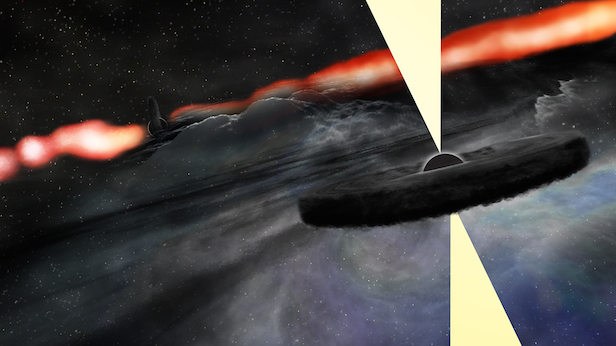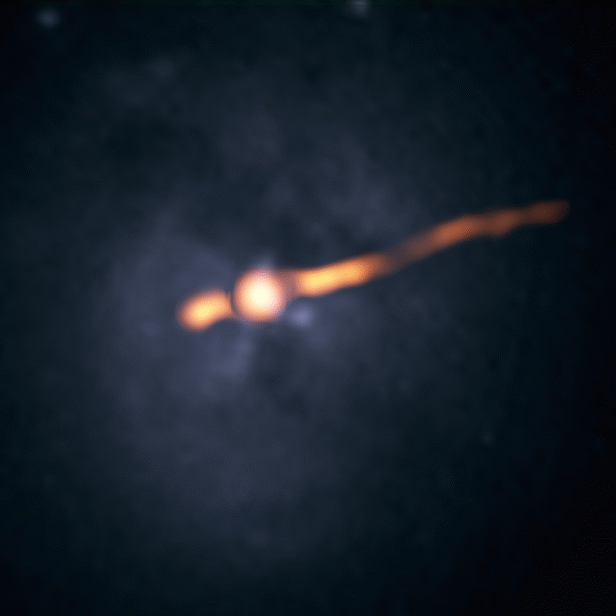New mysterious object found in familiar galaxy
Radio observations of Cygnus A show an unusual object near the centre, not shown in prior radio observations.

This is an artist’s impression of the secondary SMB orbiting Cygnus A’s central SMB. Image credit: Bill Saxton, NRAO/AUI/NSF
The Very Large Array (VLA) in New Mexico, United States, recently observed the radio galaxy Cygnus A for the first time in over twenty years. Recently, an unexplained object has become apparent, which was not present in previous radio images. Radio astronomers speculate that it is either a supernova explosion, or the more likely solution is a second supermassive black hole (SMB), in the process of merging.
Cygnus A, which resides roughly 800 million light year away, has been a long-studied galaxy since it’s discovery in 1939 by Grote Reber. After the National Science Foundation’s VLA was completed in 1980, Cygnus A became one of its first targets. With the power of twenty-seven 25-metre telescopes presented in the shape of a Y, the VLA was revolutionary for the field of radio astronomy. However, after sixteen years, technologies were improving exponentially, which required an upgrade to VLA’s equipment. In 1996, after the upgrades, another set of observations was taken of Cygnus A, and yet again nothing had changed.
“The VLA images of Cygnus A from the 1980s marked the state of the observational capability at that time, Because of that, we didn’t look at Cygnus A again until 1996, when new VLA electronics had provided a new range of radio frequencies for our observations,” says Rick Perley, of the National Radio Astronomy Observatory (NRAO). “However, the VLA’s upgrade that was completed in 2012 made it a much more powerful telescope, so we wanted to have a look at Cygnus A using the VLA’s new capabilities.”

This animation shows the VLA images in orange, from 1989 and 2015. Overlaid is an image of the galaxy by Hubble Space Telescope. Image credit: Perley, et al., NRAO/AUI/NSF/NASA
With the latest radio images gathered between 2015 and 2016, this new, bright, mysterious object appeared. Astronomers then observed Cygnus A using the Very Long Baseline Array (VLBA) in November 2016 to confirm the presence of this object. Based on these images, it is clearly separated from the supermassive black hole at the centre of the galaxy, with 1,500 light years between them. Previous infrared images of Cygnus A from Hubble Space Telescope and the Keck Observatory showed a faint object in a similar position. Infrared astronomers theorised it was a dense group of stars, but the only certain thing is that something ‘turned on’ between 1996 and now.
Due to the relatively rapid increase of brightness for an object this size, there are two possible explanations. The first possible explanation is that it is a supernova explosion, but this is unlikely, because the long duration of brightness for this object does not agree with our model for supernovae.
The second and best explanation is that it is another supermassive black hole. “We think we’ve found a second supermassive black hole in this galaxy, indicating that it has merged with another galaxy in the astronomically-recent past,” says Chris Carilli of NRAO. “These two would be one of the closest pairs of supermassive black holes ever discovered, likely themselves to merge in the future.” The astronomers believe that the recent emergence is due to the idea that the second black hole was starved of fuel, until now. This outburst could be the ‘high-gravity’ object devouring a cloud of gas, or even pulling apart a large star with its gravity. If this scenario is true, this will bring new evidence to several merging galaxies, and black holes, theories. However much more evidence is needed before such conclusions can be made.
Keep up to date with the latest space news in All About Space – available every month for just £4.99. Alternatively you can subscribe here for a fraction of the price!




